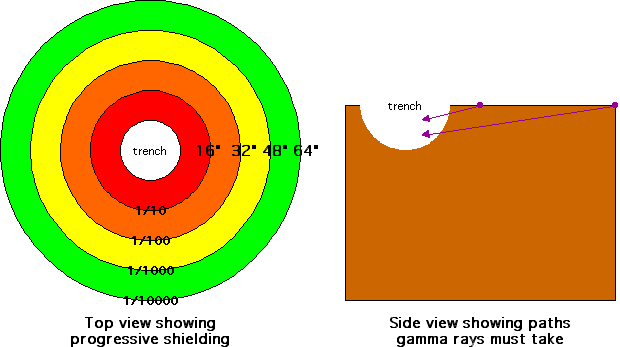 The Compass DeRose Guide to Emergency Preparedness: Hardened Shelters
The Compass DeRose Guide to Emergency Preparedness: Hardened Shelters The Compass DeRose Guide to Emergency Preparedness: Hardened Shelters
The Compass DeRose Guide to Emergency Preparedness: Hardened SheltersThis page was written by Steven J. DeRose on 2003-03-30, and was last updated on 2003-04-12.
Harm from radiation is strongly related to both total dose and dose rate. You can take a lot more radiation if it comes in small doses with time to recover from the cellular damage in between.
The ways to reduce your exposure are:
There are two main kinds of shelters:
Both kinds have the same goal as far as radiation is concerned: get as much mass as possible between you and the radiation source. Obviously a prepared shelter can be set up to do this really well; but it's surprising how well even the simplest expedient shelters can do.
There's a slightly technical but very helpful article on gamma-ray shielding here. In simple terms, just think of every particle of radioactive dust as spraying bullets in random directions.
The purpose of an expedient shelter is to put some heavy material between you and the radioactive material, as fact as possible. Consider:

A thought exercise: What is the absolute minimum list of stuff you would need to stay for a week in such a place? Now go pack it in a backpack. Don't foget a folding shovel and maybe something to pry a manhole cover off with, so you can make the shelter in the first place. Do your own list first, but if you want to compare mine, it's here.
The more shielding, the better. Shielding is measured by what fraction of gamma rays it blocks. If a certain thickness will block half of the incoming radiation, then addding the same thickness again will block half of what's left (leaving only 1/4 or the original gamma ray intensity), and so on.
Materials are commonly categorized by their "halving thickness", which is the thickness of that material required to block half of the incoming gamma rays. Sometimes "tenthing thickness" is quoted instead, which is of course the thickness required to block 90%.
An overall shield is characterized by its total "protection factor". For example, a shield that only lets 1/40 of the gamma rays through, has a protection factor of 40.
Old FEMA guidelines specified a minimum protection factor of 40 for civil defense shelters. More recent writers tend to suggest a protection factor of 1000. In effect, that will let you survive 25 times longer in your shelter (assuming nothing else goes wrong). Actually, the improvement is far better, because
This also means that every minute counts in getting into your shelter in the first place. A radiological device that goes off near you starts affecting you immediately; but dust from a nuke that goes off miles away won't settle on your area for some time; you probably have a good 20 minutes before things get very hot.
Useful information on materials protection values can be found in the Wikipedia, and on a page by PJ Deschenes and John Burke at North Carolina School of Science and Mathematics.
To achieve a protection factor of 1000, use 10 halving-thicknesses or 3 tenthing-thicknesses of any materials, or a combination. It's mainly raw mass of material that makes blocking effective. A pretty good protection estimate is that a one foot square piece of a tenthing-thickness of any material, will come out to weigh about 125 pounds (57 kg). So for a protection factor of 1000, you want about 375 pounds of mass per square foot of area you're shielding.
One effective fallout shield is 10 halving-thicknesses of packed dirt, about a yard or meter. Another would be a 9-inch concrete wall (a bit under 4 halvings) backed by 2 feet of dirt (a bit over 6 halvings).
Note that 37.5 pounds per square foot will not get you a protection factor of 100 -- it doesn't work that way. It would actually get you considerably less that 10 -- in fact more like a protection factor of 3.
Weights per unit area or volume for many more materials are given here.
| Material | Tenthing Thickness | Halving Thickness | Weight/square foot at that thickness |
|---|---|---|---|
| lead | 0.4" | ||
| concrete | 2.4" | 138 | |
| cement block (solid, porous) | |||
| steel | 3.3 in | 135 lb | |
| packed dirt | 16 in | 3.6 in | 124 lb |
| water | 24 in | 125 | |
| lumber or other wood | 38 in | 111 | |
| books | |||
| air | 500 feet |
| Number of halvings | Total protection factor |
|---|---|
| 1 | 2 |
| 2 | 4 |
| 3 | 8 |
| 4 | 16 |
| 5 | 32 |
| 6 | 64 |
| 7 | 128 |
| 8 | 256 |
| 9 | 512 |
| 10 | 1,024 |
| 15 | 32,768 |
| 20 | a million |
| 30 | a billion |
Back to home page of Steve DeRose or The Bible Technologies Group. or The Bible Technologies Group Working Groups. Or, contact me via email (fix the punctuation).